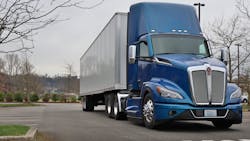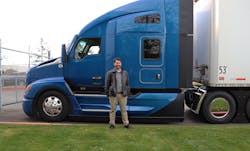RENTON, Wash.— Last week, Kenworth invited a few media members, including myself, to its Renton complex to test drive its newest Class 8 tractor, the 2022 T680 Next Generation. The T680 Next Gen received a significant refresh over the classic T680 first released in 2012.
Seeing the glimmering Deep Cerulean-hued truck up close, I could see the stark differences from even the 2020 model. My neighbor across the street sometimes parks his 2020 T680 in his driveway, so I often have that familiar grille facing me when I hop in my car. I’d venture to guess having this more aggressive version staring me down would fill me with respect and a profound feeling of inadequacy (more than usual, anyway).
Most noticeable additions on the Next Gen include the graceful curves streaking along the hood and fairings that improve aerodynamics and fuel economy. The sleeper had 28-in. side extenders to close the air gap between the tractor and trailer.
And on the inside the 15-in. dash display that intuitively provides all the data a driver needs to ensure a safe and efficient route run. It’s those squinting heated LED headlamps peeking above the fender and angled turn signal blinkers slice across back of the fenders that truly take the T680 from a clean-cut worker to a high-achieving bad boy.
For a detailed description of all the changes, take a look at our recap of the T680 Next Gen reveal from February. And here's a quick video explaining some of the new additions and reasoning behind them.
The ride and drive
Kenworth arranged for us to test drive the T680 Next Gen day cab and 76-in. sleeper models on a mild and cloudy Thursday afternoon, both hauling a 53-ft. trailer (the day cab empty for 30,000-lb. total weight and sleeper loaded to about 67,000 lbs.), completing a 40-mile clockwise loop out of the facility and through the lush, forested areas and rural outskirts east of Seattle. I shamefully don’t hold a commercial driver’s license (yet), so a fellow journalist, the incomparable Steve Sturgess, took the wheel for both routes as I played navigator and obligatory button pusher. Even as a trucking newbie, I could tell what each button did and the configuration seemed smartly arranged. The digital gauge cluster could also be controlled from the SmartWheel controls.
The wheel is also attached to the new Torque Assisted Steering, which mechanically provides additional force to the wheel when needed to reduce driver fatigue. On a 40-mile route, this would be less appreciated than a 400-mile one.
After the two loops through the Pacific Northwest country roads and highways, my initial reaction is that while I wouldn’t want to take another cross-country flight anytime soon, due to excessive mask-wearing and ergonomic torture of those cramped seats, traveling America’s scenic highways in this stunner would be an absolute blast.
For starters, the truck’s sporty new frame slices through the air with more ease than ever. When using the Paccar EPA 2021 MX-13 engine, the 76-in. sleeper provides a 6% improvement in fuel economy over a classic T680 with a 2017 MX-13.
“On the fleet and customer side, obviously, efficiency is everything,” offered Kenworth design director Jonathan Duncan prior to our departure. “When you have a large number of trucks, any little bit you can gain is a lot of money.”
“What you're trying to do with the air is either keep it from going under the truck, or you can direct it under the truck and control it as it goes down,” Duncan said. To direct the flow under the chassis, redesigned air dams were installed. When the air goes under the truck and trailer, that airflow pressurizes and reduces friction. The air comes out through narrow exhaust ports on the rear of the fender, interior to the new bladed signal indicators. The new flow also directs hot air away from the radiator and engine to improve cooling.
It’s better for air friction to direct the flow around the truck, keeping the stream connected in one continuous flow as it travels around and down the sides of the truck, which also reduces turbulence, Duncan explained.
The 2,385-mile trip in this version back home to Cleveland would be about $53 less, figuring diesel costs about $3 and assuming the 2017 version gets 8 mpg on average. On previous cross-country trips in my twenties, I would manually calculate my fuel costs every fill up to see how much overall I would spend, and how much would be left over for roadside souvenirs. For a trucker who drives 100,000 miles a year, this 6% represents a savings of $2,250 per year. And the mpg data for the Next Gen appeared at the top right of the display, so no manual math required. The top mpg Sturgess hit, by the way, was 9.9 mpg in the sleeper, and that was on fairly undulating terrain.
Speaking of terrain, due to the curved windshield, the visibility of the mossy emerald forests adorning those back roads was unobstructed, as was the view of other vehicles. Sensors also detect vehicles in the truck’s blind spot and flash a yellow caution signal on the relevant side-view mirror.
The Bendix Wingman Fusion advanced driver-assistance system, overall operated without issue. The lane-assist warning briefly popped off a few times around gentle curves on the road. The collision mitigation info was set up on the center of the display, showing the distance in seconds to the vehicle ahead at the current rate of speed. To test the system, Sturgess safely inched up to the sedan in front of us on an offramp to set it off. The whole display flashed yellow and beeped like holy heck. If a crash were imminent, it would have illuminated in red.
“Talking to drivers, what we found is they want the information to be displayed easily to them,” Duncan said. “They don't want to have to navigate around a bunch of menus. They want actionable information from the cluster.”
On our short drive, the equipment performed as expected, but if there were a problem, the display would be able to diagnose the issue and inform us if we needed to pull over or continue on to a repair facility. The powertrain, comprising the 2021 MX-13 (with 405 hp/1,750 lb.-ft. multi-torque rating) and Paccar 12-speed automated manual transmission, provided a seamlessly comfortable ride. As I was not behind the wheel I can’t comment on the responsiveness of the truck, but Sturgess operated it like he had been driving the Next Gen for years, though that could in part be due to the British expat’s cool, retired James Bondian demeanor.
The sleeper cab itself seemed similar to previous versions, though a new interior trim was added. With the Diamond VIT spec, the truck comes with tan upholstery and rich madrona inserts with diamond-pattern black stitching on the door pads. My neighbor with the 2020 T680 had mentioned how he would like more storage in the berthing area, and Kenworth did include a 5.5-in. storage shelf above the bottom bunk.
I can’t say for sure if in a few years my neighbor will trade out his classic model, which at least for the time being is still available for order, but the owner-operator is a stickler for fuel efficiency and recently has been commenting on rising diesel costs after his weekly trips. With a volatile energy future, that 6% could mean an increasing amount of savings in the next few years. Combine that with the safety features and great look of the truck, and it’s fair to say the T680 Next Gen will be a popular choice for Kenworth customers for the foreseeable future. It may even draw over some stalwarts from other OEMs. At the very least, the bold design will have every truck design engineer looking at new ways to improve aerodynamics and look good doing it.
About the Author
John Hitch
Editor
John Hitch is the editor-in-chief of Fleet Maintenance, providing maintenance management and technicians with the the latest information on the tools and strategies to keep their fleets' commercial vehicles moving. He is based out of Cleveland, Ohio, and was previously senior editor for FleetOwner. He previously wrote about manufacturing and advanced technology for IndustryWeek and New Equipment Digest.



